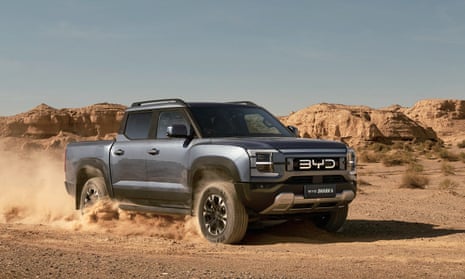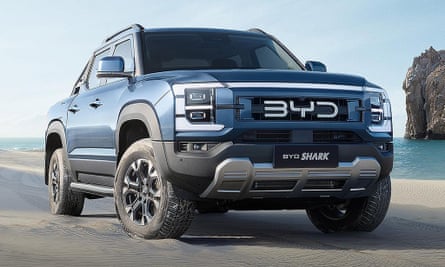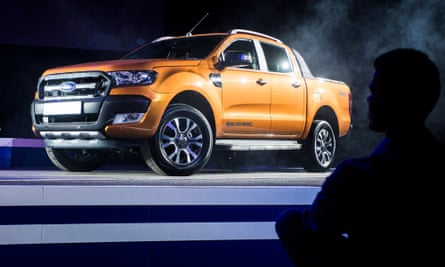
BYD’s hybrid EV ute that could rival Australia’s bestselling vehicles goes on sale
Orders roll in as Chinese carmaker launches Shark 6 in move that could signal electrification spreading from sedans and SUVs to large ute market
A new plug-in hybrid EV ute that could rival Australia’s top selling vehicles, the Ford Ranger and Toyota Hilux, has received almost 1,000 pre-orders within hours of going on sale.
The BYD Shark 6, which has a range of about 80km on battery electric before switching to petrol, could be the start of China muscling in on the market dominated by diesel vehicles.
Australian customers interested in the ute, which has an introductory price tag of $57,900, were asked to pay a refundable $1,000 deposit to secure a pre-order.
Almost 1,000 pre-orders were received but BYD expects the total to be higher because dealers were forced to manually log orders late into the night after the website crashed.
David Smitherman, the chief executive of local importer EVDirect, said the interest had been enormous.
“Over 20,000 people have expressed an interest in the Shark 6,” he said. “In my 25 years in the car industry I’ve never seen interest like this in a new vehicle.”
The Chinese carmaker, which sits second to Tesla on the EV sales charts, has clearly captured the attention of the big players.
In the days leading up to BYD’s pricing announcement – revealed on the outskirts of Broken Hill and livestreamed to dealer events around the country – rivals ramped up their marketing activity.
On Tuesday morning Toyota announced it was trialing an electric Hilux with the mining company BHP.
Within hours Ford confirmed it would this week reveal the plug-in hybrid version of its Ranger, a direct rival to the BYD that’s due in dealerships in 2025.
It’s indicative of an intensifying ute battle that will soon include Kia, which on Tuesday revealed its new Tasman that will hit the road in mid-2025 and will eventually include an EV alternative.
Changing of the guard?
While the ute market has been evolutionary and broadly predictable for years, it looks set to undergo an electric revolution mimicking what’s brewing with hatchbacks, sedans and SUVs.
From the outside the Shark 6 follows a familiar formula: four-door body with the chest-beating styling that ute buyers crave.
But beneath the skin it eschews a diesel engine for electric motors and a compact 1.5-litre petrol engine that predominantly acts as a generator.

The so-called plug-in hybrid EV – the first of many PHEV utes expected in Australia – can travel about 80km on electricity and charge overnight, allowing tradies, families and even mining companies to do their everyday driving on electrons.
But venture to the bush or outback and the Shark 6 relies on petrol, travelling up to 800km between a charge and refill.
Fuelling the fight
Once the battery has been depleted it is far less economical. In hybrid mode the Shark 6 uses a claimed average of 7.9 litres of premium unleaded every 100km. The diesel-powered Hilux dual-cab auto uses the same amount and a Ranger 2.0 slightly less (7.6L/100km).
However, those figures are according to a laboratory test. In the real world the diesel rivals typically use more, but the regenerative braking of electric motors – which puts electricity back into the battery pack when braking – means hybrids have an advantage in stop-start driving.
So the Shark 6 is very much in the hunt and, of course, it has 80km of zero fuel use before the fossil fuel starts flowing.
It’s that promise of EV that has fleets and government departments interested.
“They’re looking for vehicles like this because they’ve got targets they’ve got to hit in terms of environment numbers,” said Ross Booth, the general manager of valuations giant Redbook.
after newsletter promotion
All are trying to reduce their carbon footprint – and running costs – and electrifying the vehicle fleet is an easy way to tick a big CO2 box.
Opinions are split on whether electric can work in the bush, but Booth believes the ute market will respond.
“The impact [of Shark 6] will be substantial because it’s giving something that the market needs,” he said. “We’re pretty bullish about it.”
BYD is also undercutting alternatives powered by internal combustion engines. The Shark 6 comes with gear often reserved for luxury models, including heated and ventilated front seats, a head-up display and a Tesla-like 15.6 inch touchscreen as well as a digital instrument cluster.
Spend that money on the Ford Ranger or Toyota Hilux – which between them command more than half the ute market in Australia – and you get more modestly appointed machines.

Not that the Ranger and Hilux are about to lose their sales lead. Booth believes utes fighting in the second tier of the ute segment could come under more pressure.
“People aspire so much in the ute market to Hilux and Ranger; they’ve got such strong brands,” he said. “The market to conquer is that next level down.”
That includes a varied selection, but three he nominates as targets include the Mitsubishi Triton, Nissan Navara and GWM Cannon.
Going the distance
Despite the injection of fresh tech, the BYD ute faces blustery headwinds. Whereas most utes can tow 3.5 tonnes, the Shark 6 lugs one tonne less.
Dual-range transfer cases for solid off-road work are common in utes, but the Shark 6 does without, instead relying on tech and torquey electric motors to get power to the ground.
And the Shark 6 gets coil springs at the rear versus the leaf springs of most rivals.
But the big thing missing for the Shark 6 is reputation, which counts for plenty in the heat and dust of the outback.
Toyota in some ways owns the bush with a reputation for reliability and durability that people pay extra for.
Australians expect to be able to punish their vehicles over harsh terrain and have it come back in one piece.
Longer term the Shark 6 may well deliver, but right now it’s an unknown quantity that some may remain wary of.
“That always happens when you release a new brand,” Booth said. “There’s an uncertainty … Hilux has been in the market for 50 years.”